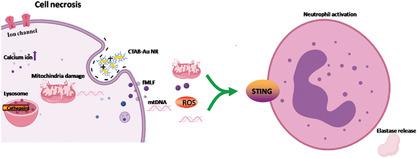当前位置:
X-MOL 学术
›
Small Methods
›
论文详情
Our official English website, www.x-mol.net, welcomes your
feedback! (Note: you will need to create a separate account there.)
Effects of Cetyltrimethylammonium Bromide on the Toxicity of Gold Nanorods Both In Vitro and In Vivo: Molecular Origin of Cytotoxicity and Inflammation
Small Methods ( IF 10.7 ) Pub Date : 2020-01-28 , DOI: 10.1002/smtd.201900799 Yan Peng Jia 1 , Kun Shi 1 , Jin Feng Liao 2 , Jin Rong Peng 1 , Ying Hao 1 , Ying Qu 1 , Li Juan Chen 1 , Li Liu 1 , Xia Yuan 1 , Zhi Yong Qian 1 , Xia Wei Wei 1
Small Methods ( IF 10.7 ) Pub Date : 2020-01-28 , DOI: 10.1002/smtd.201900799 Yan Peng Jia 1 , Kun Shi 1 , Jin Feng Liao 2 , Jin Rong Peng 1 , Ying Hao 1 , Ying Qu 1 , Li Juan Chen 1 , Li Liu 1 , Xia Yuan 1 , Zhi Yong Qian 1 , Xia Wei Wei 1
Affiliation

|
The safety issues and immunological effects of nanosized materials have drawn considerable attention. Gold nanorods (Au NRs) have promising applications in biomedical diagnosis and therapy, but their biosafety and the mechanism underlying in vivo toxicity still remain to be explored. In this study, cetyltrimethylammonium bromide (CTAB) capped Au NRs and PEG modified Au NRs are both prepared, the cytotoxicity evaluation indicates that CTAB‐Au NRs of different ratios all exhibit cytotoxicity while PEG‐Au NRs show improved biocompatibility. Furthermore, it is investigated how the surface characteristics influence toxical effects of Au NRs both in vitro and in vivo. It is found that CTAB‐Au NRs can induce acute cell necrosis, which results in the leakage of damage associated molecular patterns (DAMPs) such as mitochondrial DNA (mtDNA), subsequently triggering pulmonary inflammation. It is also revealed that the inflammation caused by CTAB‐Au NRs is probably mediated by the stimulator of interferon genes (STINGs) signaling pathway. This study explores the cytotoxicity and inflammatory toxicity of CTAB‐Au NRs, and how the surface modification affects the toxicity. The molecular pathways for the induction of pulmonary inflammation in vivo are further characterized. These findings might be of importance for designing safer and better gold‐based nanomaterials in the future.
中文翻译:

十六烷基三甲基溴化铵对金纳米棒体外和体内毒性的影响:细胞毒性和炎症的分子起源
纳米材料的安全性问题和免疫学作用引起了极大的关注。金纳米棒(Au NRs)在生物医学诊断和治疗中具有广阔的应用前景,但其生物安全性和体内毒性的潜在机制仍有待探索。在这项研究中,均制备了十六烷基三甲基溴化铵(CTAB)封端的Au NRs和PEG修饰的Au NRs,细胞毒性评估表明,不同比例的CTAB-Au NRs均具有细胞毒性,而PEG-Au NRs则具有改善的生物相容性。此外,研究了在体外和体内,表面特性如何影响Au NR的毒性作用。发现CTAB-Au NR可以诱导急性细胞坏死,从而导致线粒体DNA(mtDNA)等损伤相关分子模式(DAMP)泄漏,随后引发肺部炎症。还揭示了CTAB-Au NR引起的炎症可能是由干扰素基因(STINGs)信号通路的刺激物介导的。这项研究探讨了CTAB‐Au NR的细胞毒性和炎性毒性,以及表面修饰如何影响毒性。进一步表征了体内诱导肺部炎症的分子途径。这些发现对于将来设计更安全,更好的金基纳米材料可能具有重要意义。进一步表征了体内诱导肺部炎症的分子途径。这些发现对于将来设计更安全,更好的金基纳米材料可能具有重要意义。进一步表征了体内诱导肺部炎症的分子途径。这些发现对于将来设计更安全,更好的金基纳米材料可能具有重要意义。
更新日期:2020-01-29
中文翻译:

十六烷基三甲基溴化铵对金纳米棒体外和体内毒性的影响:细胞毒性和炎症的分子起源
纳米材料的安全性问题和免疫学作用引起了极大的关注。金纳米棒(Au NRs)在生物医学诊断和治疗中具有广阔的应用前景,但其生物安全性和体内毒性的潜在机制仍有待探索。在这项研究中,均制备了十六烷基三甲基溴化铵(CTAB)封端的Au NRs和PEG修饰的Au NRs,细胞毒性评估表明,不同比例的CTAB-Au NRs均具有细胞毒性,而PEG-Au NRs则具有改善的生物相容性。此外,研究了在体外和体内,表面特性如何影响Au NR的毒性作用。发现CTAB-Au NR可以诱导急性细胞坏死,从而导致线粒体DNA(mtDNA)等损伤相关分子模式(DAMP)泄漏,随后引发肺部炎症。还揭示了CTAB-Au NR引起的炎症可能是由干扰素基因(STINGs)信号通路的刺激物介导的。这项研究探讨了CTAB‐Au NR的细胞毒性和炎性毒性,以及表面修饰如何影响毒性。进一步表征了体内诱导肺部炎症的分子途径。这些发现对于将来设计更安全,更好的金基纳米材料可能具有重要意义。进一步表征了体内诱导肺部炎症的分子途径。这些发现对于将来设计更安全,更好的金基纳米材料可能具有重要意义。进一步表征了体内诱导肺部炎症的分子途径。这些发现对于将来设计更安全,更好的金基纳米材料可能具有重要意义。











































 京公网安备 11010802027423号
京公网安备 11010802027423号